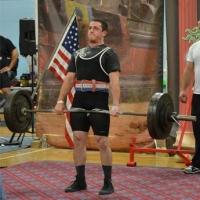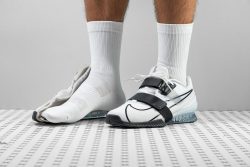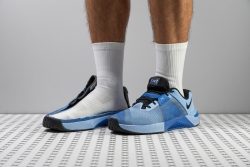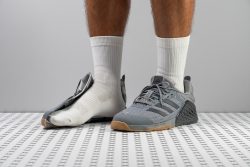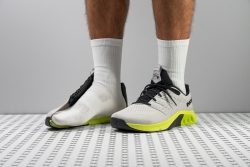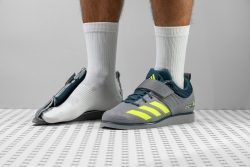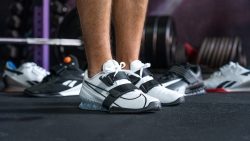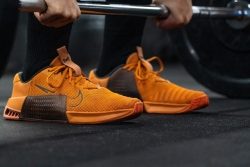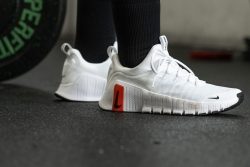7 Best Weightlifting Shoes For Men in 2025
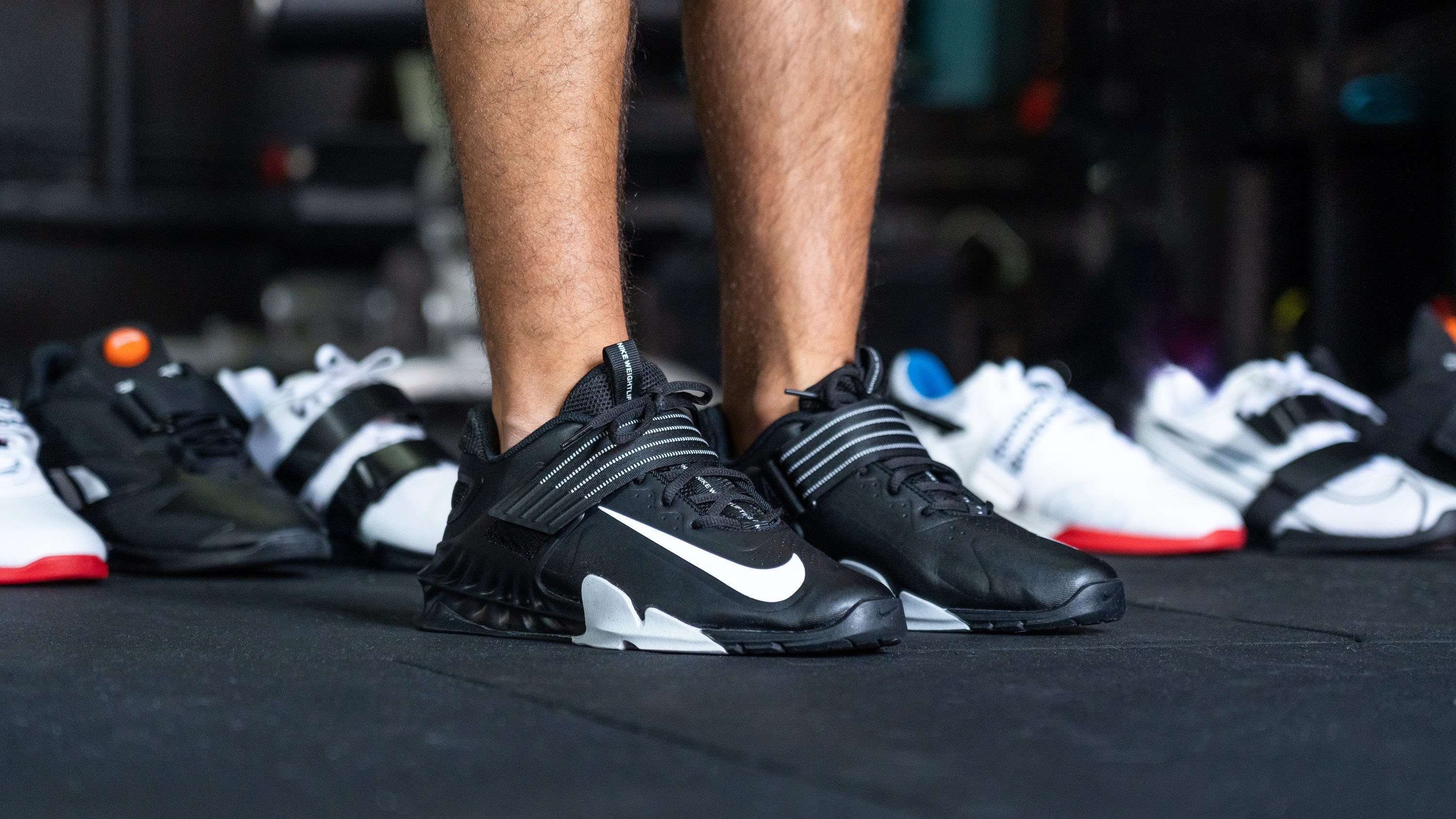
We buy shoes ourselves. We earn commissions when you buy through us, at no extra cost. Why trust us
Men’s weightlifting shoes come in different shapes and sizes but which one is the best for you?
Whether it’s for strength training in general or for Olympic lifting in particular, we are here to help you find the best shoe for your needs and budget.
You can choose one of our top picks below for a quick solution or dive deeper into the nuances of lifting shoes with our in-depth guide below.
How we test weightlifting shoes for men
Our testing process begins even before a shoe arrives in our lab as we purchase all weightlifting shoes with our own money to avoid bias and brand loyalty.
The next step involves testing the trainer’s performance during squats, cleans, jerks, and snatches for a hands-on experience.
After that, we subject each shoe to the most meticulous evaluation in our lab where we use specialized equipment to test every measurable parameter that affects its fit, feel, and performance.
The gathered data serves as a foundation for our comprehensive reviews and top picks of weightlifting shoes for men.
Best weightlifting shoes for men overall






























What makes it the best?
During our gym sessions, the Nike Romaleos 4 delivered unmatched steadiness that gave us the confidence to load up the barbell. Our lab results indicate that it has a wide, stiff, and robust base that provides excellent stability with no compression or imbalance, making it our ultimate men’s weightlifting shoe.
The platform feels very firm and sturdy, evidenced by its very high 97.0 HA durometer reading. For reference, that’s 40.2% firmer than the average lifting shoe! This reading confirms why we had no worries going for our PR weights and why we think it’s even suitable for intermediate male lifters. In addition, its elevated heel (20.5 mm drop) helps anchor our feet to the ground when carrying heavier loads.
Romaleos 4 also features a broad and stiff base that helps with stability. Our caliper shows the base is 111.5/91.3 mm, giving us more room to find our footing securely vs. the 107.7/86.7 mm average.
It felt impossible to topple over with its secure foothold. We tried twisting the shoe, and it had no give, so we rated it with the maximum 5/5 torsional rigidity. The heel also offers firm support, evidenced by its solid 5/5 stiffness rating.
However, men with narrower ankles might experience some slight heel slippage when performing squats. Men who want to avoid this discomfort should go for another pair.
Pros
- Phenomenal stability
- Sturdy platform and sole
- Better lockdown with two straps
- Comfortable for a lifting shoe
- True to size
- Efficient traction
- Appealing looks
Cons
- Upper lacks durability
- Not for narrow ankles
- Not breathable
Best men's cross-training shoes for weightlifting















































What makes it the best?
The Nike Metcon 10 took our gym training to the next level with its superior stability, adaptive build, and performance-enhancing grip. Our lab results show its reliability for lifting and flexibility for other exercises is undeniable, making it our top cross-trainer among men’s weightlifting shoes.
Metcon 10 delivers reassuring support through its strong resistance to twisting and lateral movements, validated by its high 4/5 torsional rigidity score in our assessment. In addition, it doesn’t compress under a loaded barbell since it has a Hyperlift plastic in the heel.
Metcon 10 features a grounded 22.8/16.2 mm stack, enhancing surface feedback and control. It also made our feet feel more at home during foot-bending workouts like planks. In our bend test, it emerged 13.2% more pliable than average, a surprising result for a steady lifter.
As we performed burpees and lifted on sweaty gym floors, the outsole’s sticky grip did its job of keeping us steady and in control. In our traction test, it surpassed the average by 11.8%, meaning it delivers stronger traction.
However, Metcon 10 is not the best option for hot and high-sweat sessions. Men who need maximum ventilation should go for another pair.
Pros
- More versatile Metcon overall
- One of the lightest Metcons ever!
- ReactX adds shock absorption and energy return
- Increased forefoot flexibility
- Still amazingly stable for weightlifting
- Fantastic upper durability (even for rope climbs)
- Great grip on gym floors
- Highly secure foot lockdown
- Accommodating fit and toebox
- Handy Lace Tuck
Cons
- Outsole could be more durable
- Upper lacks breathability
Best men's weightlifting shoes for beginners
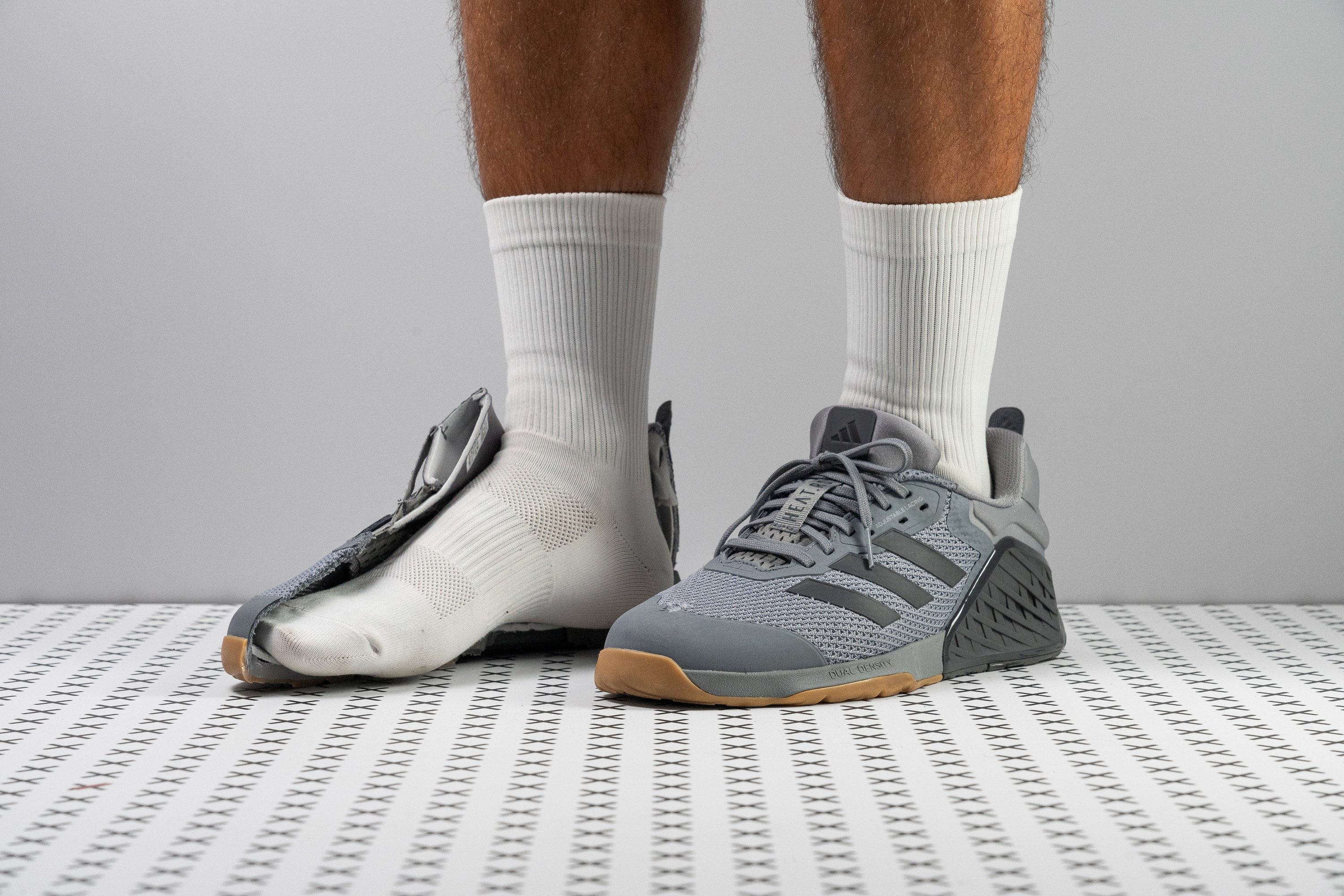





















































What makes it the best?
The Adidas Dropset 3 gave us a safe and secure foothold without feeling too overpowering and harsh on foot, making it our ideal beginner’s weightlifting shoe for men. Testing further in the lab, we discovered it has a dual-density midsole and awesome grip that stabilizes us without compromising comfort and flexibility for other workouts.
The Dropset 3's robust base allows us to push off safely when lifting weights. Our durometer shows a high 41.0 HA reading, 47.5% harder than the average training shoe. Meanwhile, a plush 21.5 HA foam covers the forefoot section for impact protection when performing jumps and other exercises, perfect for men who incorporate various workouts when strength training.
The shoe offers a well-planted sensation through its TPU wall and firm rubber overlay on the medial side. Despite these sturdy features, Dropset 3 doesn't feel stiff, as confirmed by its 3/5 torsional rigidity rating in our manual assessment. We also experienced secure ankle support that feels comfortable, thanks to the GeoFit Sensepods.
The Dropset 3 offers a reliable grip for lifts and floor workouts, validated by its impressive 0.39 score in our traction test. The midsole also allows us to move freely, with a flexibility score 25.2% above average, making it versatile enough for men who are starting to add lifting to their routine.
Unfortunately, we can’t recommend this pair for walking and running because of its cumbersome heel. Men looking for a more agile shoe should try alternatives.
Pros
- Exceptional stability for lifting and lateral movements
- Very wide and grounded platform
- Extra durable and grippy outsole
- Very secure foothold
- Flexible enough for plyometrics
- Fantastic breathability
- Accommodating toebox
Cons
- Not great for running and walking (clunky heel)
- Can't be worn outside because of sole apertures
Best men's weightlifting shoes for advanced athletes
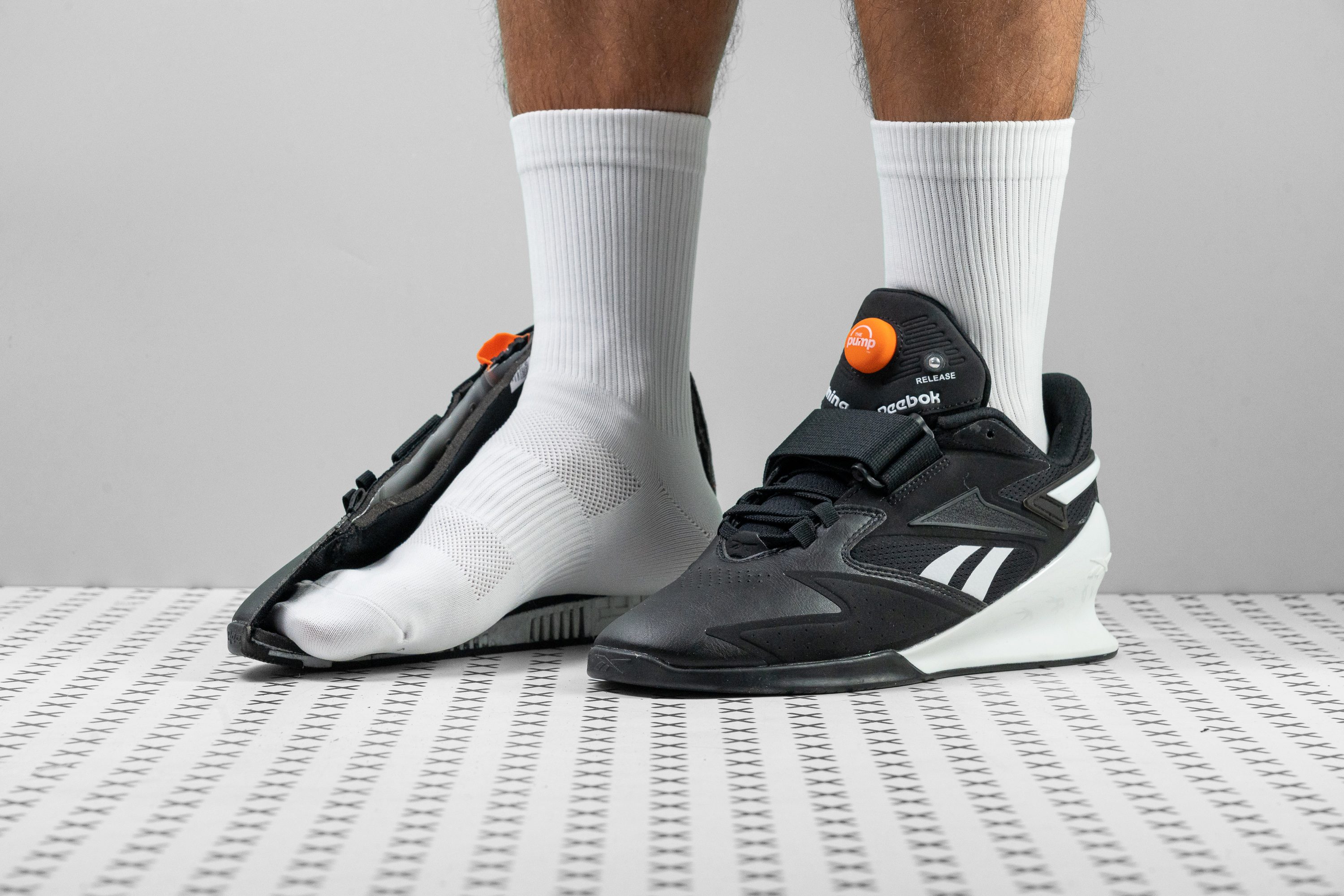




































What makes it the best?
Our lab tests show the Reebok Legacy Lifter III combines a sturdy platform, a robust build, and an elevated heel, which explains the highly stable sensation we had while lifting the heaviest loads. It feels so secure that it can support even those who regularly lift more than 300 lbs. With its solid construction, it’s our top weightlifting shoe for advanced male athletes.
We felt no compression underneath even as we loaded the barbell with PR-level weights. Our durometer shows a wildly high reading of 95.1 HA, 37.4% firmer than average. The rear is also elevated, with a steep 20.5 mm drop, which reduces pressure in the knees and ankles because it allows us to lift efficiently.
Men seeking a very secure foothold won’t be disappointed in this lifter. During our trials, we had no instances of losing our stance, and we felt locked in. Any attempts to twist the shoe with our hands or pinch the heel counter had no effect, so we awarded both with the maximum 5/5 rigidity rating.
This shoe has a heavy 22.1 oz (627g) build, which helps us feel anchored to the ground. Being 26.2% heavier than average, it takes a lot of effort to topple over in this shoe.
However, note that its Velcro attachment runs short. The best way to adjust the shoe’s fit is by using the inflatable Pump in the tongue. Men who prefer a more traditional adjustment feature should go for another pair.
Pros
- Mind-blowing stability
- Incompressible platform
- High heel helps with posture for squats
- Highly supportive upper
- Top-notch durability
- The Pump feature is fun and improves the fit
Cons
- Unreasonable price hike
- Short Velcro attachment
Best men's weightlifting shoes for deadlifts















































What makes it the best?
Adidas The Total took our strength training to the next level with its stability and secure lockdown. Lab results reveal it has a true zero drop and a firm base that offers enhanced surface sensitivity and surefootedness. Meanwhile, its foot strap and grippy outsole reassure us we can move with control, making the Total our top deadlifting shoe for men.
Using our caliper, we measured the minimal stack at only 12.5 mm in the heel and forefoot vs. the 28.3/12.9 mm average. This mirrored the heightened ground feel we experienced, and confirms the Total is a true zero-drop shoe. These features promote better balance, especially since the firm 40.0 HA base doesn’t compress easily under heavy loads.
Even as we tested new PR weights, the shoe’s reassuring fit gave us the confidence to lift. With a Velcro strap near the ankle, it felt supportive with its firm foothold. Meanwhile, the grippy base allowed us to move with precision and proper form, perfect for men who frequent slippery gym floors.
Surprisingly, this shoe weighs only 11.5 oz (327g). Men who like to feel anchored through hefty shoes should go for another pair because the Total is 34.2% lighter than average.
Pros
- Ideal for deadlifting
- Great traction
- A lot of ground feel
- Plenty of toebox space
- Lightweight and comfortable
- Fairly priced
- Streamlined look
Cons
- Not so much breathability
- Not for heavy squats
Best men's hybrid weightlifting shoes
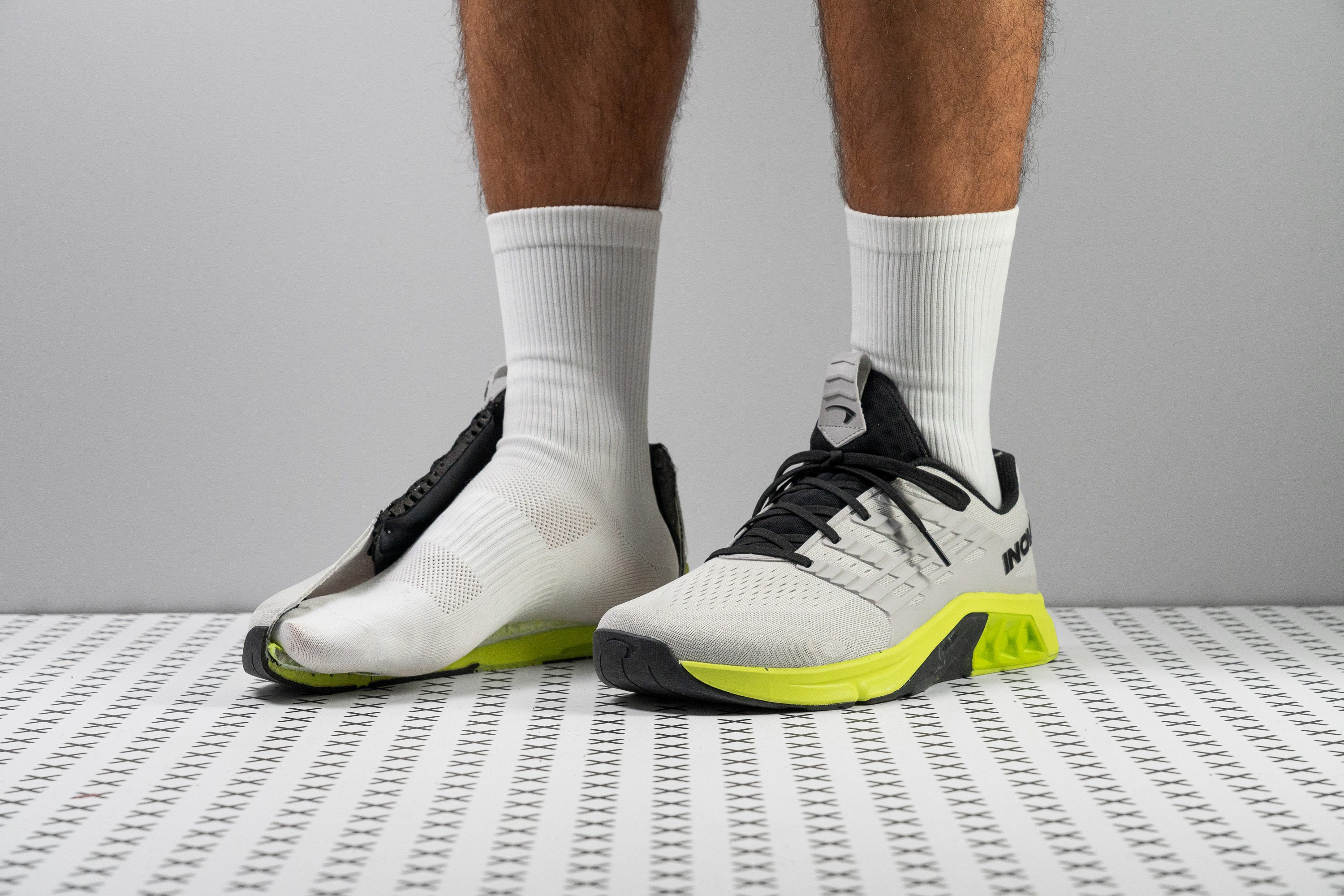























































What makes it the best?
The Inov8 F-Lite Max was a delight to test during our gym sessions because it made us feel safe when trying out heavier loads while giving us the freedom to move during other exercises. Testing further in the lab, we discovered it combines stiff stability elements such as the TPU Heel Stabilizer and the Met-Cradle cage, with more forgiving elements such as the responsive and flexible forefoot. Ultimately, it’s our best hybrid weightlifting shoe for men.
F-Lite Max features an impressive combination of a rock-solid heel and a bouncy forefoot. Our durometer shows the TPU Heel Stabilizer is an incompressible 88.0 HA so that it doesn’t surrender to a fully loaded barbell. Meanwhile, the forefoot is a well-balanced 35.0 HA, making it suitable for men seeking energy return during jumps.
The midfoot features a robust Met-Cradle cage that prevents any foot collapse or ankle twists. Its high 4/5 torsional rigidity result mirrors how it had very little give during our manual twist assessment.
Thankfully, the midsole has a lot of give in terms of bending, allowing us to perform planks and burpees with minimal effort. The outsole has deep flex grooves in the forefoot that boost versatility. In our bend test, it emerged 6.3% more adaptive than average.
While its extraordinarily wide toebox is great for stability and control, men with narrow feet should look elsewhere to avoid swimming inside the shoe.
Pros
- Fantastic stability for lifting and Crossfit
- Great for heavier lifting (stiff TPU heel)
- Awesome for wide feet
- Good forefoot flexiblity
- Highly breathable toebox
- Solid outsole durability
- Protection for rope climbs
- The stickiest outsole rubber
Cons
- Heavier than average
- Clunky and firm for HIIT/cardio
- Frail upper fabric
Men's weightlifting shoes with the best value for money
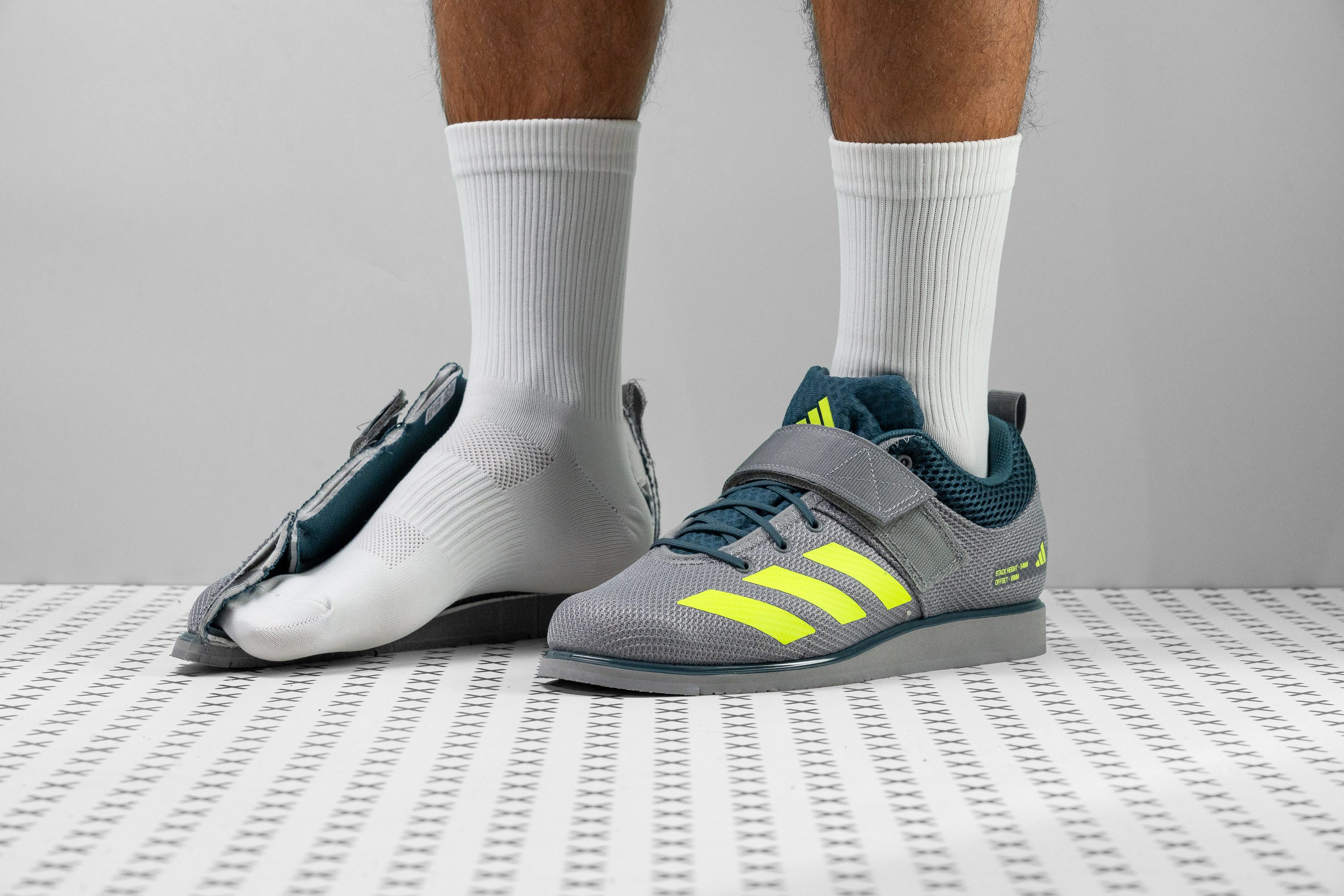













































What makes it the best?
For only $120, we enjoyed reassuring support and flexible adaptability in one shoe: the Adidas Powerlift 5. Backed up by lab results, its light build and bendability make it easy on the foot while offering sturdy support through its torsion-resistant midsole, making it our best-value weightlifting shoe for men.
The Powerlift 5 made us feel fully supported under heavy loads. We tried to twist the shoe with our hands, and it had no give, earning the maximum 5/5 torsional rigidity rating. On foot, this translates to a well-planted sensation.
Aside from squats and lifts, the midsole moves with our feet so that we can perform other gym exercises such as lunges and burpees. Our bend test confirms it’s 15.8% more bendable than average.
Its light 15.0 oz (425g) weight also enhances its effortless sensation. Being 14.5% below average, it’s a great match for men who perform agile workouts, too.
However, it lacks ventilation for heated workouts. Men who prefer a breathable shoe should try alternatives.
Pros
- Stable base for moderate lifting
- Good for accessory exercises
- Solid bite on gym floors
- Secure foothold
- Supportive Velcro strap
- Reasonably priced
- Contains sustainable materials
Cons
- Lacks breathability
- Upper is not very durable
- Tongue shifts
Reasons to buy weightlifting shoes for men
Weightlifting shoes (aka lifting shoes, lifters, squat shoes) are an advantage if:
- you focus on Olympic weightlifting in your training
- you squat with a heavy barbell regularly
- you have poor ankle mobility and struggle with squat depth
- you want to experience maximum stability and confidence under heavy loads
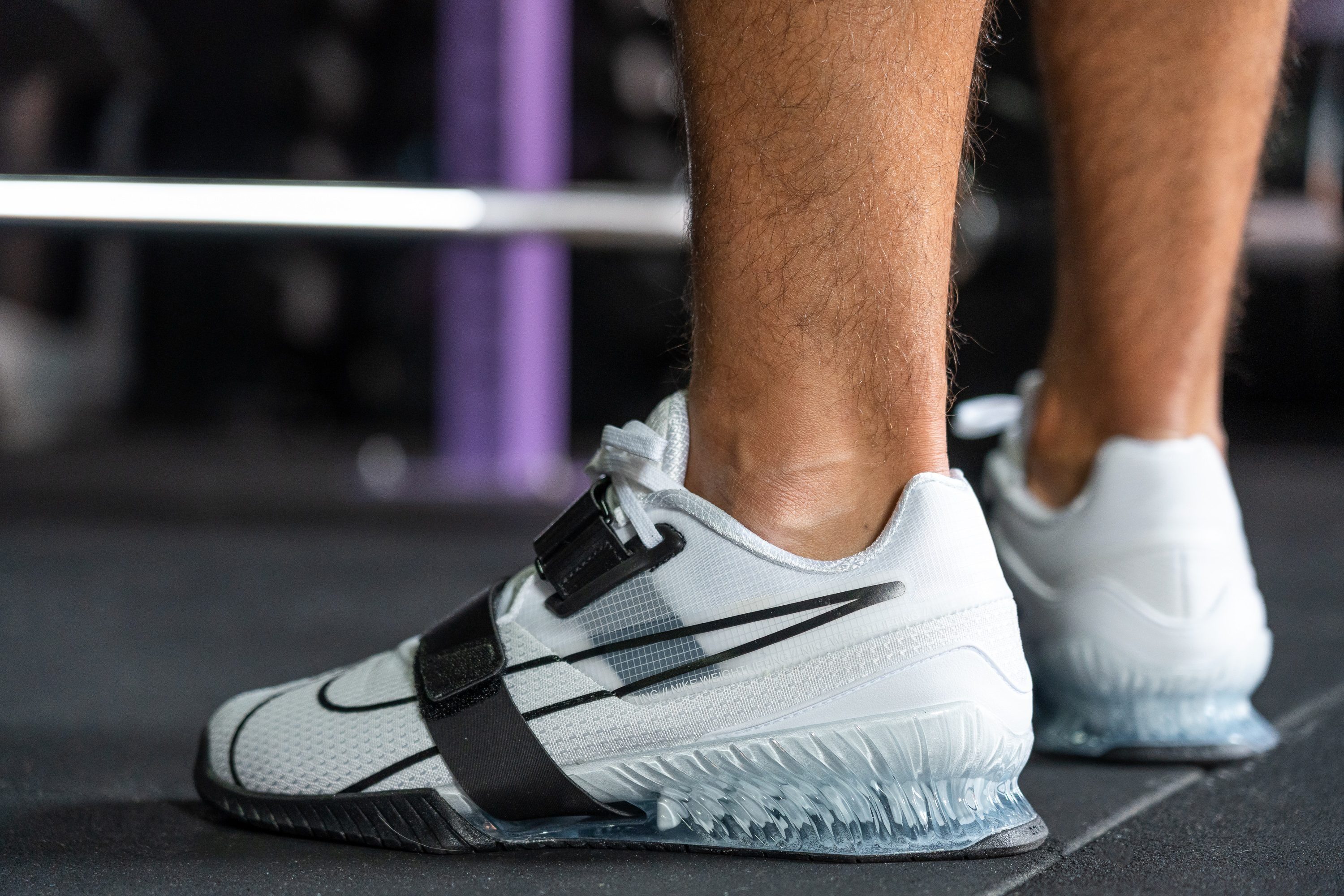
Lifting shoes are specifically designed for Olympic weightlifting movements like squats, cleans and jerks, and snatches. But they can also be used for accessory gym exercises, such as front squats, split squats, lunges, leg presses, hack squats, and step-ups.
The intended use of these shoes is reflected in their unique characteristics such as:
High heel-to-toe drop: Elevates the heel above the toes to help athletes achieve deeper squats with a more upright torso. Other benefits include:
- compensation for limited ankle mobility
- better activation of quads due to increased knee flexion
- less stress on the spinal discs as a result of a more upright torso
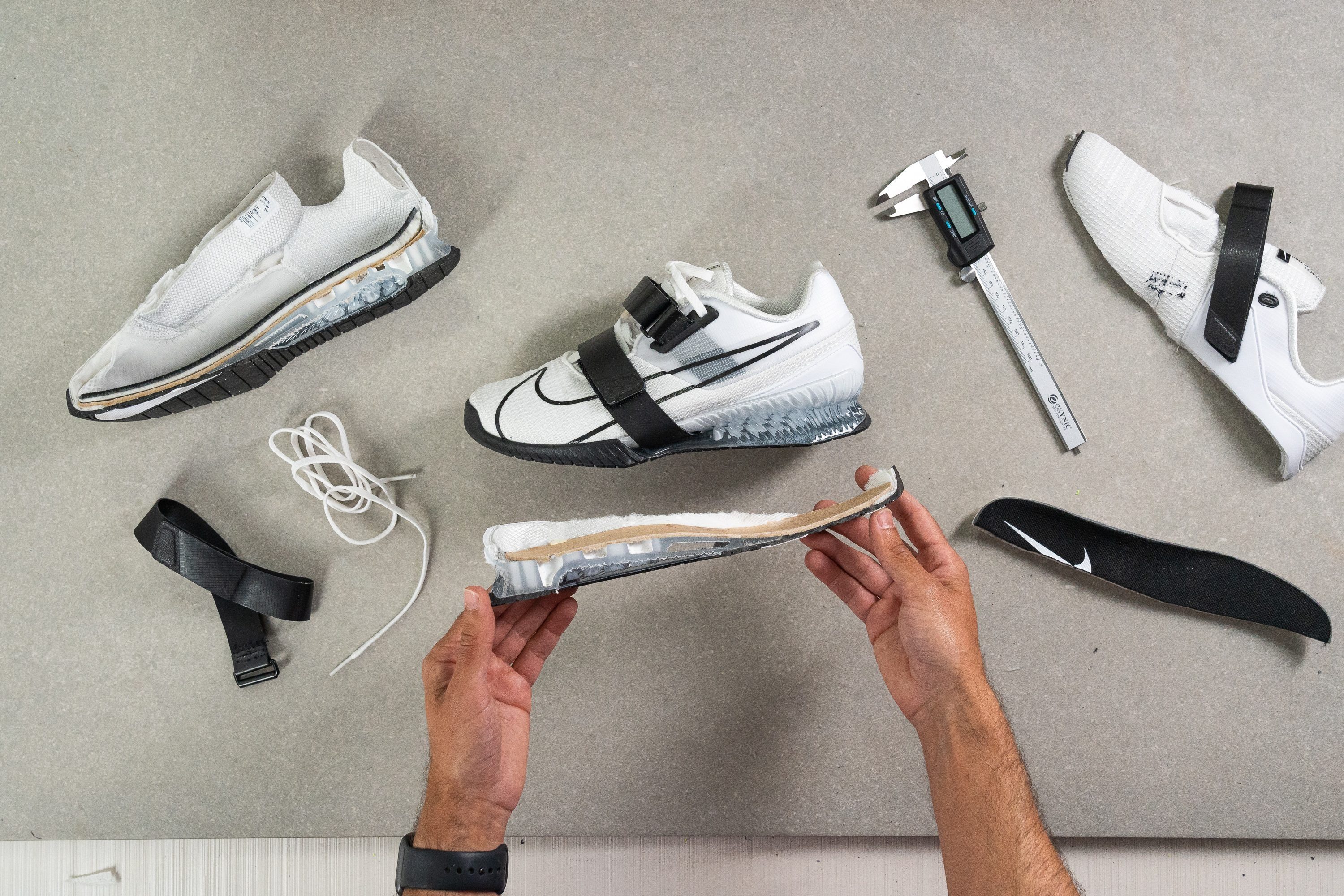
Firm incompressible platform: The hard base of these shoes makes sure that none of the power you generate is lost on its way from your feet to the barbell.
High torsional rigidity: Makes them very supportive in the midfoot which reduces the risk of ankle rolling under the heavy load. This stiffness works together with the firm platform to provide the most efficient power transfer when lifting.
Flat, wide, and grippy outsole: Feeling the ground evenly from the heel to the toes creates much better ground contact and weight distribution as you dive in and out of a squat. Lifting shoes also have wide bases to provide extended contact points with the floor for enhanced stability.

Secure foot lockdown: Lifting shoes have stiff uppers with Velcro straps or BOA closures offering the most snug and secure fit to eliminate foot wobbling or shifting.
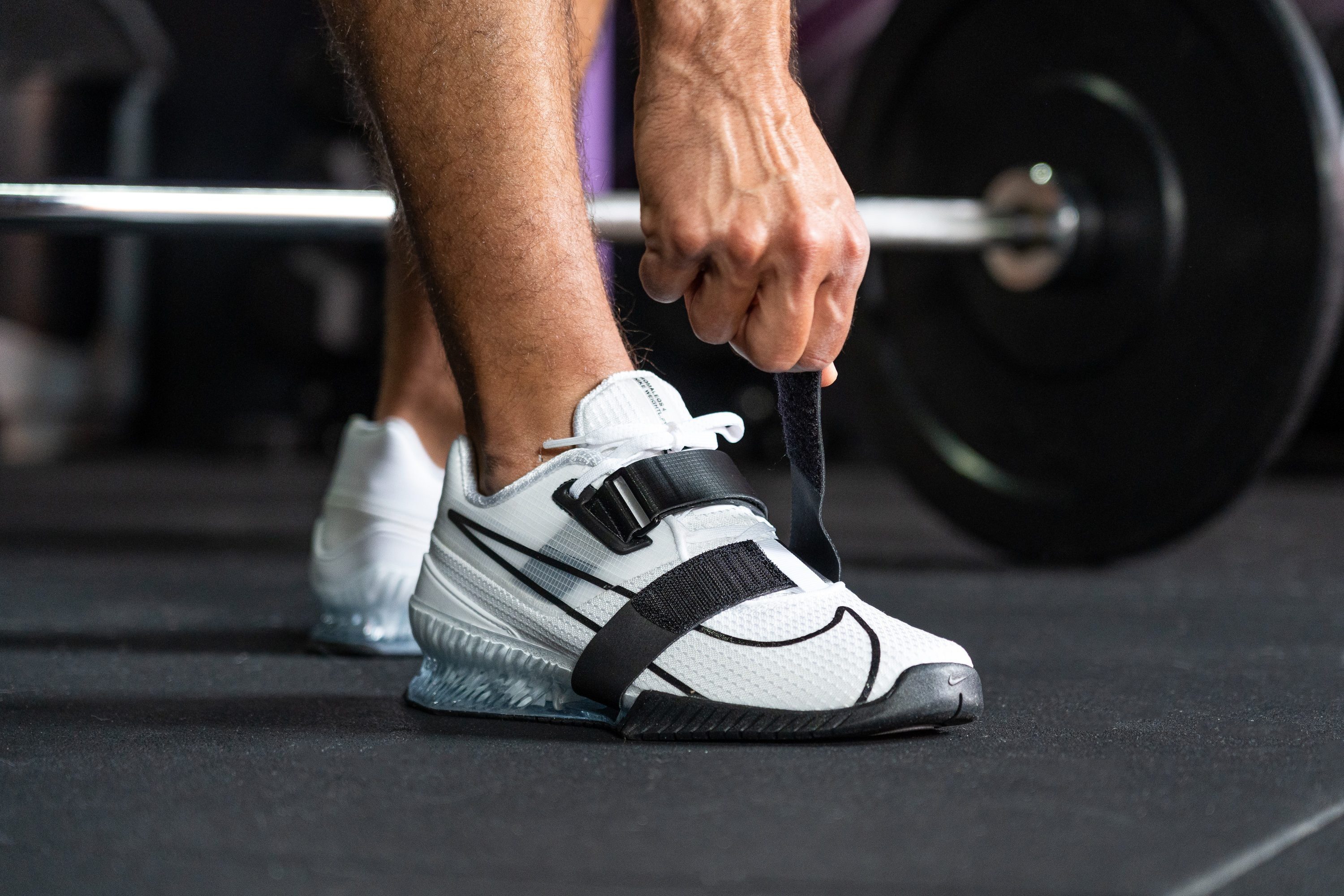
Reasons NOT to buy weightlifting shoes for men
Stiff weightlifting shoes can be an overkill or even a nuisance if:
- you are a beginner gym goer who trains with bodyweight or moderate weight
- you need a versatile cross-trainer to perform different kinds of gym exercises including jumps and agility training
- you use rowing machines, stationary bikes, and treadmills in your workout routines
- you need a shoe for deadlifting
In this case, you are much better off with a pair of cross-training shoes for men.
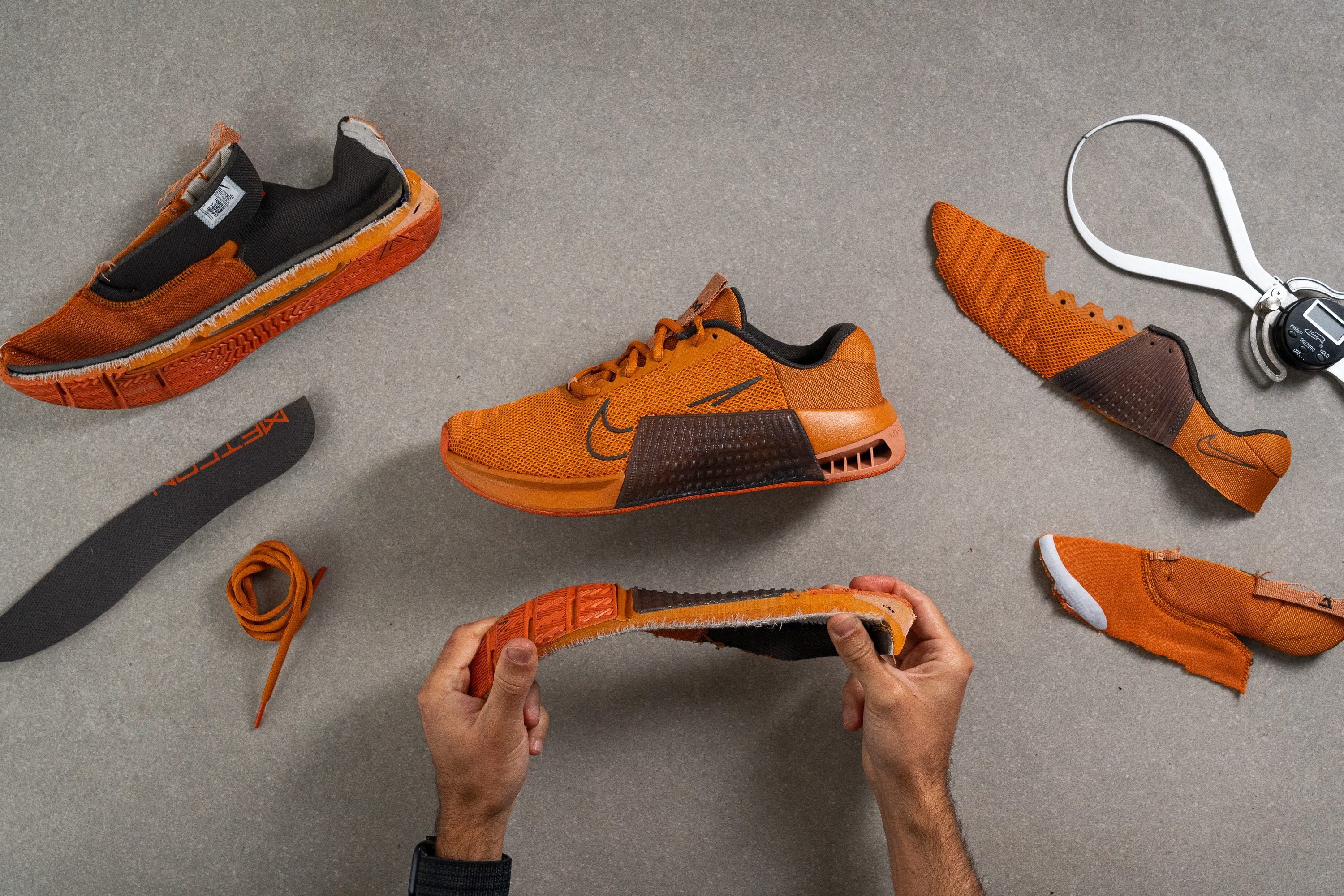
These shoes are better equipped for dynamic plyometric exercises (box jumps, burpees, skaters) and can even tackle some short runs (up to 1-2 miles) while still being stable enough for lifting up to 300 lbs (135 kg).
Cross-training shoes are generally lighter, feel a bit softer and cushier, and bend more easily in the forefoot compared to weightlifting shoes. However, they come in all shapes and sizes ranging from minimalist trainers to robust lifting shoe hybrids.
To learn more, see our guide on the best cross-training shoes for men.
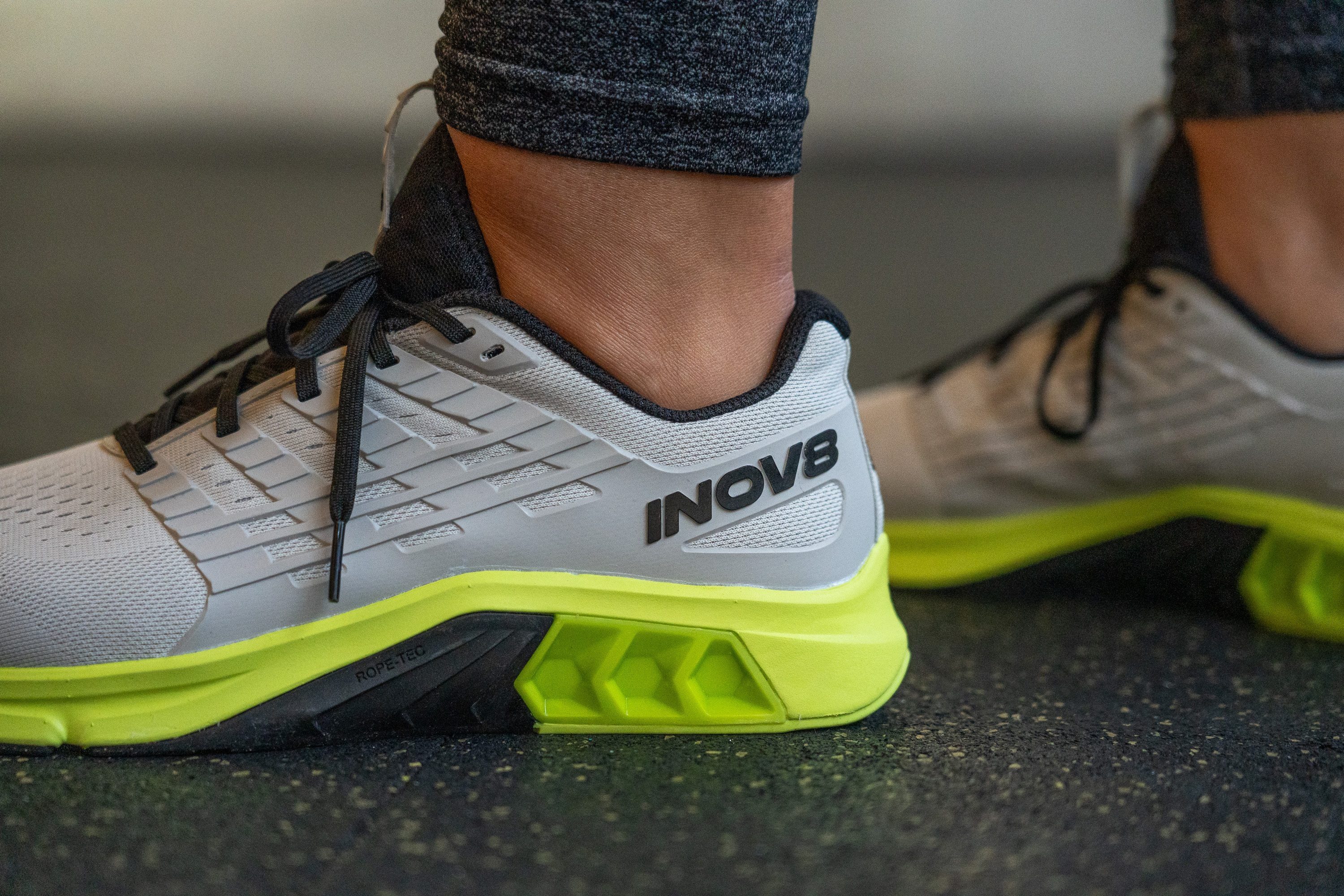
For deadlifts, in particular, it is recommended to get a zero-drop shoe as it puts the foot in a more optimal foot position for maintaining balance when the weight is in front of your body. A high-heeled shoe would compromise balance by forcing you to lean too far forward.
You can choose a specialized deadlifting shoe (i.e. Adidas The Total), a low-drop or zero-drop cross-training shoe, a minimalist trainer, or even your socks (if your gym venue allows that).
Some people also swear by their Chuck kicks for deadlifting but we don’t think it’s the most optimal choice given their 8+ mm drop and narrow pointy toeboxes that restrict the toe splay.
Choosing the right men’s weightlifting shoe for you
Weightlifting shoes vary in how they fit, feel, and perform. To help you understand which model suits you best, we recommend paying attention to the following characteristics:
- heel-to-toe drop
- forefoot flexibility
- platform hardness
- size and fit
Heel-to-toe drop
The heel is not equally high in all lifting shoes. Some have an offset of 15 mm (0.6 in), while others rise to 22 mm (1 in).

So how to choose the right drop for you?
The answer lies in your experience, squatting style, and the length of your femur (thigh bone).
| The lower drop is better if: |
|
| The higher drop is better if: |
|
*This study found that experienced lifters are more likely to benefit from the elevated heel compared to beginners. That’s why a high-heeled lifting shoe is not a necessity for beginner athletes but it is a potential advantage.

Forefoot flexibility
Even though lifting shoes are generally quite stiff, the amount of forefoot flexibility varies depending on the model.

Rigid shoes (20-30N): Most optimal for heavy-loaded barbell squats.
Moderately flexible shoes (10-20N): More forgiving for lunges, Bulgarian squats, sled pushes, step-ups, and walking around the gym.
Platform hardness
All weightlifting shoes have firm platforms that don’t compress easily under heavy weight. However, they are not equally dense.
You will find that hybrid shoes and beginner-friendly lifting shoe options are a bit more forgiving which makes them more walkable and also affordable. They use compressed EVA as it is cheaper than the TPU used in the more advanced options.

Thus, it makes sense to choose shoes based on the weight you normally lift and that doesn’t necessarily mean the firmest shoe ever made. If you are a beginner who lifts light-to-moderate weight, you can cut down the costs by choosing a less hard platform:
Size and fit
Even though you should aim for a snug fit in a men’s weightlifting shoe, it should not feel restrictive either.
The ideal fit would imply no wiggle room for your foot to shift around as you are balancing yourself under a heavy load.
The best place to start is to measure your current foot length as precisely as possible and consult the corresponding brand’s size chart. This will increase your chances of ordering the correct shoe size online.
And what about the shoe’s width and toebox fit?
We create one-to-one gel molds of each shoe’s interiors to measure their dimensions.
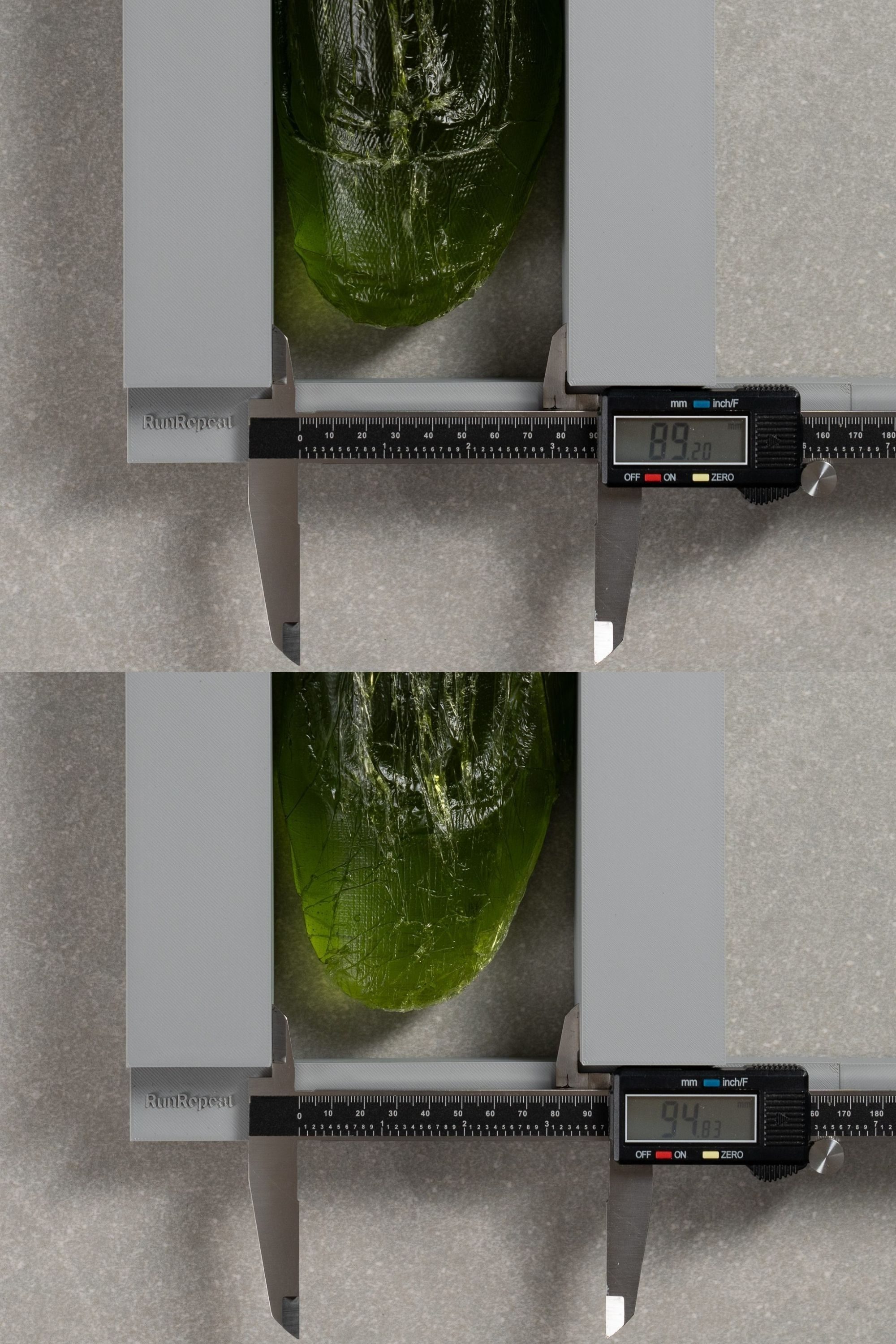
The dimensions include each shoe’s width in the widest part (ball of foot area) as well as toebox width and toebox height (near the big toe).

*If you have black or ingrown toenails, hammer toes, claw toes, and similar deformities, choose weightlifting shoes with higher toeboxes.
